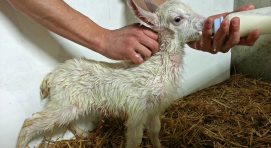
photo: Dirk Boogerd
What is colostrum?
- Colostrum – rich in nutrients and antibodies – is produced by the doe in late pregnancy.
- Goat kids are born without any antibodies and rely totally on the colostrum feeding in the first day of life for disease protection in the first few weeks of life.
Why is colostrum necessary?
- Once colostrum is consumed the antibodies are absorbed through the small intestine and into the blood stream.
- Failure of passive transfer of immunity (FPT) is the term given to a newborn animal that has not received adequate immunity from the colostrum consumed. Ability to absorb antibodies begins to decline 30 minutes after birth. FPT can also be caused by poor quality colostrum.
Sourcing colostrum
- Do not feed pooled colostrum or colostrum that is runny, thin, contains blood, or comes from does with mastitis or that were treated with antibiotics.
- Commercial colostrum replacement products are of bovine origin, which may impact their effectiveness in helping kids build antibodies.
Collecting colostrum
- Use standard clean milking practices: wear gloves, clean the udder and ensure all milking equipment is sanitized before collecting colostrum.
- Collect colostrum within 15 minutes of kidding.
- Heat-treating colostrum can be an effective method to help control major production-limiting diseases such as Johne’s disease and Caprine-Arthritis-Encephalitis (CAE).
- Bottles, buckets and nipples should be washed using soap and hot water (80°C). They should then be rinsed with a 10 per cent bleach solution. Let dry before using.
Storing colostrum
- Do not leave colostrum at room temperature as bacterial counts double every 20 minutes.
- Fresh colostrum can be refrigerated without degrading for up to 48 hours.
- Freezing colostrum should be standard practice. Package in 250 mL quantities in freezer bags or bottles and mark the date on the outside. Frozen colostrum is best used within six months.
- Colostrum should be thawed in a warm water bath around 50°C.
Feeding colostrum
- An average kid weighs approximately three kilograms (kg) at birth. The general rule for feeding colostrum is 50 mL per kg of bodyweight four times within the first 24 hours of life.
- If the kid is too weak to drink, use an esophageal tube.
For more information see: Ontario Goat’s “Colostrum management for commercial goat production”
